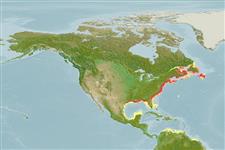Common names from other countries
分类 / Names
俗名 | 同种异名 | Catalog of Fishes(属, 种) | ITIS | CoL | WoRMS | Cloffa
Issue
Vladykov, 1955 is recognized as a valid species with constant diagnostic characters easily observable, with disjunct distribution, after it was recognized for a long time as a valid subspecies (Ref. 124040).
Environment: milieu / climate zone / depth range / distribution range
生态学
海洋; 淡水; 半咸淡水 居于水底的; 溯河洄游 (Ref. 51243); 深度上下限 1 - 46 m (Ref. 4639). 亞熱帶的; 56°N - 10°S, 102°W - 33°W (Ref. 54265)
Western Atlantic: Hamilton River, Labrador, Newfoundland, Canada to northeastern Florida, USA. Occurs occasionally in Bermuda and French Guiana (Ref. 7251). Northern Gulf of Mexico (Ref. 26938). In Europe: Baltic Sea. Landlocked populations in Lakes Ladoga and Onega (Russia), both now extirpated. Occasionally recorded from Great Britain and North Sea in Elbe drainage (Ref. 59043). Recent research revealed that this species existed in the Baltic Sea, but is now extirpated (Ref. 83384, 83385). Near threatened globally, but extirpated in Europe (Ref. 59043).
西大西洋: 漢彌爾頓河,拉布拉多,加拿大紐芬蘭到美國的佛羅里達東北方。 偶見於百慕達群島與法屬圭亞那。 (參考文獻 7251) 墨西哥灣北部.(參考文獻 26938) 國際間的買賣限制。 ( 引用2, 自從 28.6.79 以後)
Length at first maturity / 大小 / 重量 / 年龄
Maturity: Lm 201.7, range 183 - 243.8 cm
Max length : 403 cm TL 雄鱼/尚未辨别雌雄; (Ref. 26938); 430.0 cm TL (female); common length :250 cm TL (female); 最大体重: 0.00 g; 最大年龄: 60 年 (Ref. 39404)
简单描述
检索表 | 型态特徵 | 形态测量图
背棘 (总数) : 0; 背的软条 (总数) : 30 - 46; 臀棘: 0; 臀鳍软条: 22 - 32. Elongate fish, pentagonal in cross section and shark-like fins (Ref. 26938). Double row of pre anal shields. Presence of a soft fontanelle. Bony shields are oval. Carina on dorsal shields do not have a conspicuous hook. Head and back bluish-black and lower surface whitish (Ref. 37032). Snout long, sharply V-shaped. 2 pairs of short, slender barbels in transverse line midway between end of snout and anterior edge of mouth (Ref. 4639). Viscera pale (Ref. 7251). Presence of 4 small scutes, usually as 2 pairs between anal fin and caudal fulcrum (Ref. 86798).
细长的鱼, 横切面为五角形与像鲨鱼一样的鳍.(参考文献 26938) 两列的前肛门的盾甲。 出现一个软的囱门。 骨质盾甲是椭圆形的。 在背甲上的 Carina 不有一个显着的钩。 头部与背部蓝黑色的与下表面微白色的.(参考文献 37032) 吻长的, 锐利 V 形。 在吻端与嘴的前缘之间的横切线中途中的 2 对短又细长的触须.(参考文献 4639) 脏白色的.(参考文献 7251)
Anadromous species. Occurs solitarily or in small groups; inhabits shallow waters of continental shelves. At the sea, it occurs in coastal and estuarine areas on soft bottom (Ref. 59043) down to a depth of 50 m (Ref. 89115). Adults are highly migratory while at sea (Ref. 57533) and make long migrations along the coast (Ref. 59043). Feeds on benthhic invertebrates such as mollusks, crustaceans and aquitic insects from the sediments (Ref. 93252). They forage mainly in brackish waters (Ref. 59043). Ascend large rivers to spawn (Ref. 59043). Juveniles may remain in fresh or brackish water until 2-5 years of age or 76-91.5 cm long (Ref. 4639, 59043). Today most individuals do not exceed 250 cm length. Tagging studies have shown that this species may move distances up to 1,450 km (Ref. 89119). Used smoked and fresh (Ref. 37032). Near threatened globally, but extirpated in Europe due to massive overfishing, damming, river regulation and pollution (Ref. 59043).
栖息于大陆架的浅水域。 上溯到沿海的河川产卵。 卵底栖, 测量 2.55 mm 直径而且在 17.8 °C 在 1个星期内孵化.(参考文献 9980) 稚鱼可能直到 3-5 岁逗留在淡水或半淡咸水或 76-91.5 公分长.(参考文献 4639) 雌性花 8 到 30 年达成性成熟而且只有每 3-4 年产卵一次。 精确的产卵时间仰赖温度。 (参考文献 26938) 使用烟熏与生鲜地.(参考文献 37032)
Matures at increasing ages with increasing latitude (Ref. 88171). Both sexes do not spawn yearly and spawning intervals may vary according to area. In the St. Lawrence River, males spawn every 1-5 years, females every 3-5 years (Ref. 89103). Adults from the sea begin to ascend the lower reaches of large rivers in spring with the majority ascending immediately prior to spawning. Spawning occurs between March and August (Ref. 59043), when water temperature is 13.3-17.8 °C (Ref. 89118). Spawning occurs over bedrock, boulders or gravel bottoms, in depths exceeding 10 m at current velocities of 0.5-0.8 m/s (Ref. 59043, 89103). Exact time of spawning depends on temperature (Ref. 26938). Per female 0.4-8 million eggs may be spawned (Ref. 45706, 84845, 89137). Eggs demersal, sticking to stones, measuring 2.55 mm in diameter and hatching in 1 week at 17.8 °C (Ref. 4639, 9980). Adults return to the sea after spawning (Ref. 59043). Sturgeons in general have a high capacity for hybridization and most species are able to cross-breed (Ref. 89103, 89117). 西大西洋: 漢彌爾頓河,拉布拉多,加拿大紐芬蘭到美國的佛羅里達東北方。 偶見於百慕達群島與法屬圭亞那。 (參考文獻 7251) 墨西哥灣北部.(參考文獻 26938) 國際間的買賣限制。 ( 引用2, 自從 28.6.79 以後)
Page, L.M. and B.M. Burr, 1991. A field guide to freshwater fishes of North America north of Mexico. Houghton Mifflin Company, Boston. 432 p. (Ref. 5723)
人类利用
渔业: 商业性
工具
特别资料
下载 XML
网络资源
Estimates based on models
Preferred temperature (Ref.
115969): 4.3 - 24.4, mean 17.3 (based on 268 cells).
Phylogenetic diversity index (Ref.
82804): PD
50 = 0.5000 [Uniqueness, from 0.5 = low to 2.0 = high].
Bayesian length-weight: a=0.00324 (0.00142 - 0.00736), b=3.17 (2.99 - 3.35), in cm Total Length, based on LWR estimates for this Genus-body shape (Ref.
93245).
营养阶层 (Ref.
69278): 3.4 ±0.50 se; based on food items.
回复力 (Ref.
120179): 非常低的, 最小族群倍增时间超过14 年 (K=0.03; tm=7-34; tmax=60; Fec=1.03 million).
Fishing Vulnerability (Ref.
59153): Very high vulnerability (85 of 100).
